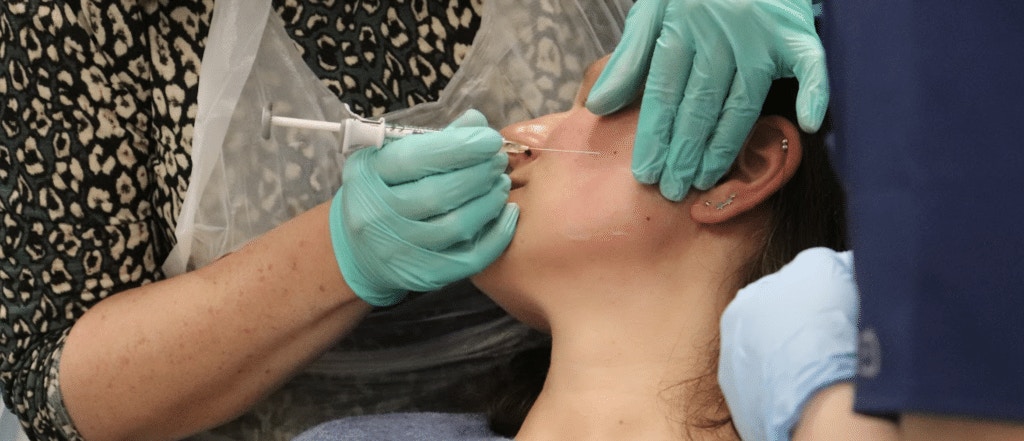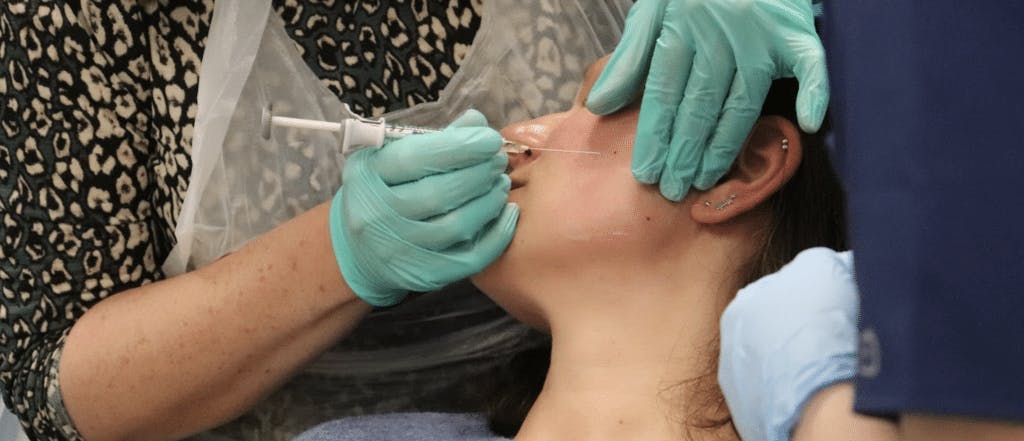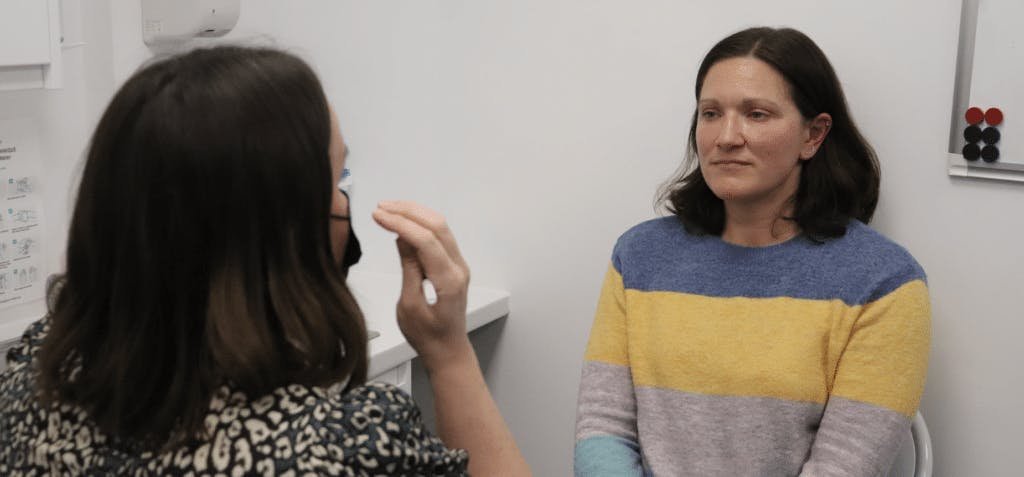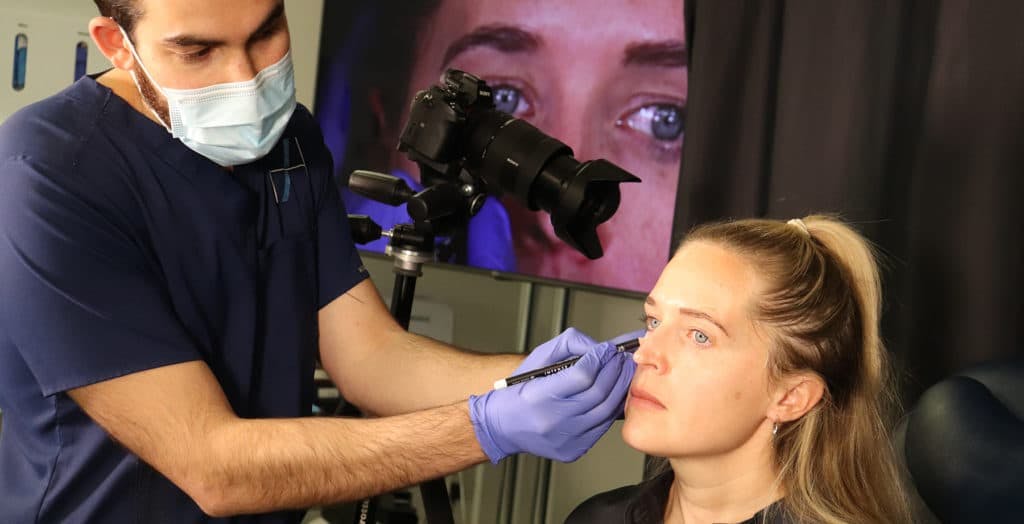Effective MidFace Filler Combinations

Once you’ve got a solid handle on the basic individual filler treatments it’s time to learn how to put them together! We thought we’d start exploring this topic by looking at effective midface filler combinations. After all, the midface is the foundation for many facial rejuvenation treatments.
Natalie Haswell is an accomplished cosmetic nurse prescriber, aesthetics clinic owner, Harley Academy senior clinical trainer and Allergan Institute board member. We interviewed her to get her valuable insights into the basics of combining midface filler treatments.

When should you look to combine filler treatments to improve the appearance of the midface?
atients often assume the midface to mean cheek filler and may ask for this when this is not the treatment – or the only treatment – that will address their concerns. We asked Natalie how best to determine when a combination approach is appropriate.
“Knowing when more than a cheek augmentation is required comes not only from education, but also from experience and knowledge of the ageing process,” she states. Adding, “The information accrued from a good consultation and examination can inform a midface treatment plan in alignment with the patient’s goals.”
“Training, mentoring and supervision from more experienced medical injectors will help with this. Attending conferences and observing renowned injectors is also beneficial; Comma is also a great resource for treatment videos to observe.”

Assessing your patient
Each patient has a unique facial structure, presentation and goals. As such, the consultation is the most important part of any treatment appointment. What many injectors find once they start treating patients, is a difference between the patient’s requests and their desired outcome. For example, patients may request “cheek filler” when their goal translates to the desire to look younger by restoring volume. It is down to you to properly assess and discuss with them the way(s) in which their goals may be best achieved.
Nat explains this well, telling us, “Differentiating what type of treatment the cheek filler is, is important. Is it a beautification, restoration or rejuvenation treatment? Or is it a desired outcome that we want to achieve that involves more than one of these options? Is there evidence of bony resorption, fat pad atrophy and general ageing to address?
“Always assess the patient holistically for suitability and from the whole face perspective, from top to bottom. This includes the face shape, profile and dynamic components on movement. This is paramount to achieving a natural, balanced and proportionate result.
“We want to ensure that, when treating the midface and cheeks, we do not over-treat and exacerbate other ageing areas. Examples of this can be highlighting or creating the appearance of hollow temples and/or a hollow pre auricular area with cheek zygoma treatments. This can make patients appear older, negating the possibility of a rejuvenated and more youthful appearance.
“If a patient requests cheek fillers but, by restoring volume to their cheeks, you may worsen the appearance of hollowing elsewhere, you could suggest midface filler combinations to address these presentations simultaneously.”

Minimising the risks with midface filler treatments
Patient safety should be the primary concern for all aesthetics practitioners. We asked Natalie for her insights on minimising risks when it comes to midface filler treatments and combinations.
“No area treated with filler is safe, however, treating the midface laterally and the ageing process deeply can carry a lower anatomical risk,” she advises. “This is because there are less major facial arteries and vessels to occlude. However, it is always possible and the risk is never eliminated no matter if you aspirate or use a cannula. You’re only ever lowering the risk. Therefore, treating the midface laterally offers a lower risk compared to more medial and superficial areas, such as the nasolabial folds.”
When assessing risk for fillers, Natalie recommends you always consider the correct:
– Patient selection
– Filler product
– Injection technique
– Ideal tool(s) – needle or cannula
– Anatomical depth
– Anatomical Layer
– Use of small volume, low pressure boluses.
“Doing so will reduce the risk of undesired complications and side effects,” she explains.

What are the most effective midface filler combinations?
Natalie likes the following midface filler combinations and explains why…
“Tear troughs and midface filler treatments can be a great combination. Treat the midface first though as this can often reduce the need to inject the higher risk tear trough areas.
“Temples, tear troughs and midface fillers, when clinically indicated, can give great, holistic rejuvenating results. Or, if minimal ageing is evident, mid- and lower face treatments can also provide effective filler combinations.”
She further notes, “We generally use these treatments predominantly on females aged 30 plus. This is, however, always dependent on the patient’s ethnic background, medical history, social history including gender presentation, and physical appearance.”
Adding, “The ‘ideal’ traditionally feminine face shape is said to be heart-shaped. This involves ensuring minimal evidence of hollowing and a bizygomatic distance slightly larger than the bigonial distance. Therefore, consider the treatments that can be combined to achieve this, based on your patient’s unique presentation and goals.”

Efficient midface and upper face filler combinations
Of course, midface filler combinations can also include treating other areas. We asked Natalie for her thoughts on treatments that are often efficiently combined with midface fillers. Ths is what she told us…
“Temple filler can, I feel, benefit midface treatments – if clinically indicated – as well as the piriform fossa to lift the head of the nasolabial fold,” says Natalie. “However, I would always treat the temples and midface first, prior to the tear troughs or lower face.
“Upper face treatments can be used, but confer added risk, so should be conducted by more experienced practitioners.”
Overall, she advises how longer lasting combination filler treatments have a number of benefits:
– Fewer treatments and visits for the patient
– Reduced amount of time in clinic
– More cost effective for patients in the long term.
“In contrast, superficial lower face filler has a reduced longevity. It requires more regular treatments which obviously come with their associated, more frequent visits and costs,” she points out.
“Overall, a treatment plan suggesting deep and lateral treatments first is preferable. This is because they address concerns from an ageing perspective more safely and effectively.”

Learning how to combine filler treatments
We have a number of options for licensed doctors, dentists, nurses or midwives who want to learn how to safely perform and combine filler treatments.
Beginner level
For beginners and those wishing to have an introduction to aesthetic medicine, the best course of action is to undertake The Aesthetics Accelerator. This short aesthetics course involves hands-on injecting and is underscored by a full eLearning education suite which must be completed prior to the in-person sessions. Accelerator training allows for a more extensive medical aesthetics initiation than our one-day Foundation Training in Medical Aesthtics.
Beginners & intermediate level
Beginners or intermediate level aesthetics practitioners looking for a formal qualification, can take our industry-leading Level 7 Diploma in Cosmetic Injectables. This respected qualification, which is recognised by our regulatory partners, the Joint Council of Cosmetic Practitioners (JCCP), will prepare you for every aspect of real world clinical practice. Experienced trainers will walk you through everything from anatomy, facial and skin ageing concepts to consultation skills, patient assessments, product properties, preventing and managing complications, as well as lots of hands-on, mentored injecting.
This gold-standard post-graduate qualification equips you with a well-rounded, advanced knowledge of the who, why, where and hows of aesthetic medicine, as well as the practical skills to back this up.
For intermediate and advanced aesthetics specialists wanting to level up their skills in particular area or formalise their training, we have two additional pathways.
Intermediate and advanced practitioners
Advanced practitioners with at least three years of experience as a cosmetic injector looking to formalise their training and futureproof their career can opt for our Fast Track Level 7 Diploma in Botox and Dermal Fillers. This offers flexible learning and can be completed in 6-12 months, versus 12-36 months for our standard Level 7 Diploma injectables course.
Intermediate and advanced injectors looking to refine their filler technique in specific areas can book our popular Injectables Masterclass sessions. There, you will treat your own patient under the guidance of one of our expert mentors. These Injectables Masterclasses cover specific regions of the face so you can really hone your focus to get the most from your mentoring.
If you’re finding the number of options a bit overwhelming, our team is here to help. Book a call with our Courses Team who can explain your best options and help set you up for aesthetics excellence!
All information correct at the time of publication
Download our full prospectus
Browse all our injectables, dermal fillers and cosmetic dermatology courses in one document
By submitting this form, you agree to receive marketing about our products, events, promotions and exclusive content. Consent is not a condition of purchase, and no purchase is necessary. Message frequency varies. View our Privacy Policy and Terms & Conditions
Attend our FREE open evening
If you're not sure which course is right for you, let us help
Join us online or in-person at our free open evening to learn more
Our Partners













STAY INFORMED
Sign up to receive industry news, careers advice, special offers and information on Harley Academy courses and services

